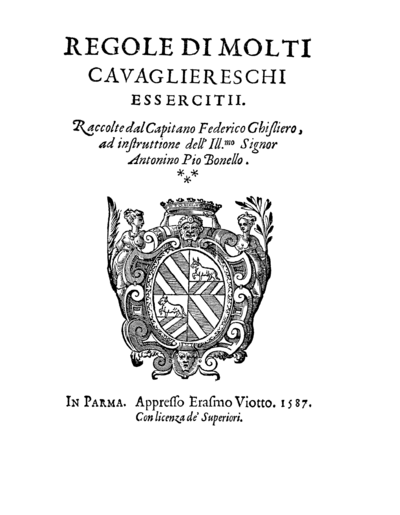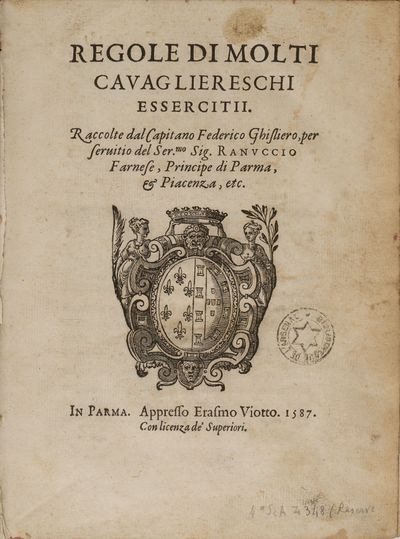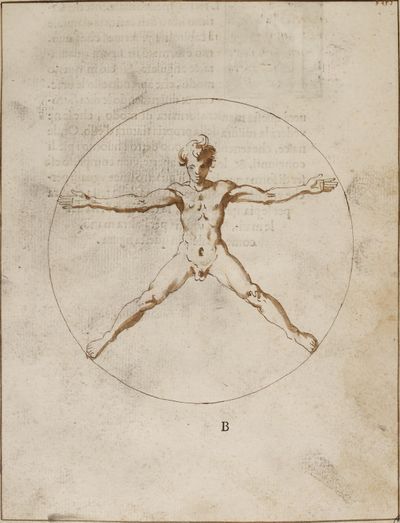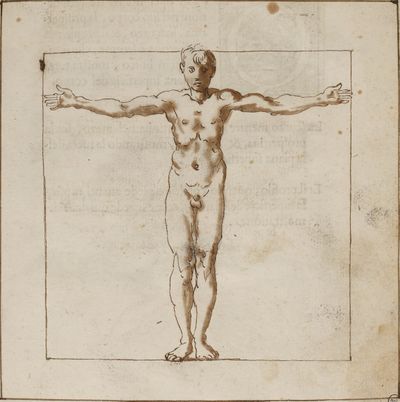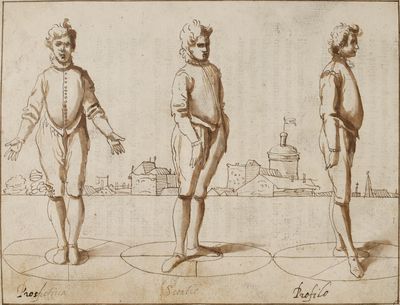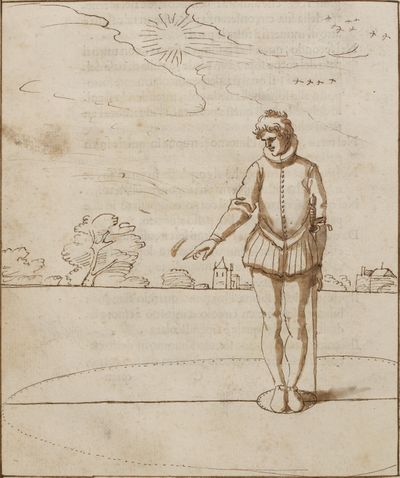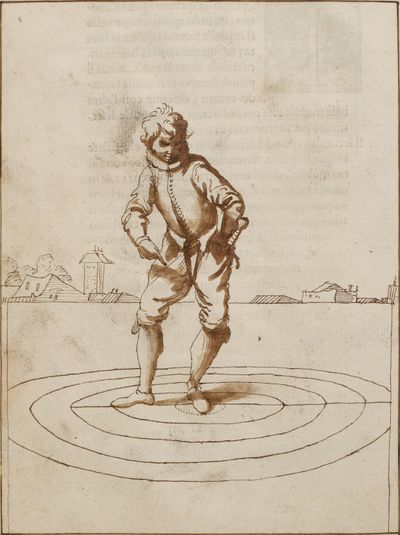|
|
You are not currently logged in. Are you accessing the unsecure (http) portal? Click here to switch to the secure portal. |
Difference between revisions of "Federico Ghisliero"
| Line 44: | Line 44: | ||
|- | |- | ||
| − | | rowspan="2" | [[file:Regole di molti cavagliereschi essercitii Title (alt).png|400px|center]] | + | | rowspan="2" | [[file:Regole di molti cavagliereschi essercitii Title (alt).png|400px|center|border]] |
| <p>'''Rules of many knightly<ref name="Cavagliereschi">''Cavagliereschi'' is Corsican for "chivalrous", while the Italian is "knightly".</ref> armies,'''</p> | | <p>'''Rules of many knightly<ref name="Cavagliereschi">''Cavagliereschi'' is Corsican for "chivalrous", while the Italian is "knightly".</ref> armies,'''</p> | ||
| Line 173: | Line 173: | ||
|- | |- | ||
| | | | ||
| − | | <p>'''Rules of Many''' | + | | <p>'''Rules of Many Knightly Armies'''</p> |
| − | <p>''Collected by Captain Federico Ghisliero, for the service of the Most Serene Lord | + | <p>''Collected by Captain Federico Ghisliero, for the service of the Most Serene Lord ''R<small>ANUCCIO</small>'' Farnese, Prince of Parma, & Piacenza, etc.''<ref>The version dedicated to Antonino instead reads "...for the instruction of the Most Illustrious Lord Antonio Pio Bonello".</ref></p> |
| − | |||
| − | |||
| {{section|Page:Regole di molti cavagliereschi essercitii (Federico Ghisliero) 1587.pdf/15|1|lbl=1}} | | {{section|Page:Regole di molti cavagliereschi essercitii (Federico Ghisliero) 1587.pdf/15|1|lbl=1}} | ||
{{section|Page:Regole di molti cavagliereschi essercitii (Federico Ghisliero) 1587.pdf/15|2|lbl=-}} | {{section|Page:Regole di molti cavagliereschi essercitii (Federico Ghisliero) 1587.pdf/15|2|lbl=-}} | ||
| + | |- | ||
| + | | | ||
| + | | <p>'''I''' have been considering several exercises of arms, which while different, contribute to the subtlety and nobility of the Cavalier;<ref>Cavalier – ''cavaliere'' – knights – so indicating the noble nature of the art which he is presenting. [note from Henry Fox]</ref> for whom understanding how to use the sword, more than any other instrument, will be important to defend his honour, both in sudden assaults, as well as in close combat, so as to be the one who is victorious, and achieves honour through feats of arms. To avoid confusion, as many have done in writing about this art, we will begin with as the principle of all our exercises, by considering the nature of man when altered by the power of the soul and his passions, and how that hinders his reason.</p> | ||
| + | | | ||
{{section|Page:Regole di molti cavagliereschi essercitii (Federico Ghisliero) 1587.pdf/15|3|lbl=-|p=1}} {{section|Page:Regole di molti cavagliereschi essercitii (Federico Ghisliero) 1587.pdf/16|1|lbl=2.1|p=1}} | {{section|Page:Regole di molti cavagliereschi essercitii (Federico Ghisliero) 1587.pdf/15|3|lbl=-|p=1}} {{section|Page:Regole di molti cavagliereschi essercitii (Federico Ghisliero) 1587.pdf/16|1|lbl=2.1|p=1}} | ||
| Line 344: | Line 346: | ||
# then the motion of the arms; | # then the motion of the arms; | ||
# then the motion of the leg; | # then the motion of the leg; | ||
| − | <p>so as not be confused we can say this is the most important principle, and leave the rest up to the painter.<ref>George | + | <p>so as not be confused we can say this is the most important principle, and leave the rest up to the painter.<ref>[[George Silver]]’s theory of the time for the hand and foot from his 1599 text ''[[Paradoxes of Defence (George Silver)|Paradoxes of Defense]]'' mirrors this framework. [note from Henry Fox] (Silver, 1599)</ref></p> |
| {{section|Page:Regole di molti cavagliereschi essercitii (Federico Ghisliero) 1587.pdf/28|2|lbl=14.2}} | | {{section|Page:Regole di molti cavagliereschi essercitii (Federico Ghisliero) 1587.pdf/28|2|lbl=14.2}} | ||
| Line 508: | Line 510: | ||
! <p>{{rating|C}}<br/>by [[Nicole Boyd]]</p> | ! <p>{{rating|C}}<br/>by [[Nicole Boyd]]</p> | ||
! <p>Transcription<br/>by [[Nicole Boyd]]</p> | ! <p>Transcription<br/>by [[Nicole Boyd]]</p> | ||
| + | |||
| + | |- | ||
| + | | | ||
| + | | <p>''Having said that we have the fencer, or the architect, it is good to continue to describe the matter; since the action of stabbing is self-evident.''</p> | ||
| + | | {{section|Page:Regole di molti cavagliereschi essercitii (Federico Ghisliero) 1587.pdf/35|1|lbl=21.1}} | ||
| + | |||
| + | |- | ||
| + | | | ||
| + | | <p>As the motion, and the matter, around which the man operates in this act of stabbing them, we have to know that movement, according to what Aristotle defends in the ninth text of his fifth book of the ''Physica'',s<ref>Aristotle’s fifth book of the ''Physica'', which considers how motion occurs. “Book V classifies four species of movement, depending on where the opposites are located. Movement categories include quantity (e.g. a change in dimensions, from great to small), quality (as for colours: from pale to dark), place (local movements generally go from up downwards and vice versa), or, more controversially, substance. In fact, substances do not have opposites, so it is inappropriate to say that something properly becomes, from not-man, man: generation and corruption are not kinesis in the full sense.” (Aristotle, ''Physica'' (Book 5), (384–322 BC) 2007) “Generally things which come to be, come to be in different ways: (1) by change of shape, as a statue; (2) by addition, as things which grow; (3) by taking away, as the Hermes from the stone; (4) by putting together, as a house; (5) by alteration, as things which ‘turn’ in respect of their material substance.” Book 1, ''Physica'', Aristotle (Aristotle, ''Physica'' (Book 1), (384-322 BC) 2007)</ref> is a mutation, or transmutation: the types of which some want to be six; i.e. Generation, Corruption,<ref>Change of shape.</ref> Augmentation,<ref>By addition or by growing.</ref> Decreasing,<ref>Also taking away or removing.</ref> Alteration,<ref>Putting things together or building.</ref> and Mutation<ref>Change of material substance or alteration of its substance.</ref> place-to-place. None other than Aristotle himself in the first section<ref>“Three kinds of motion - qualitative, quantitative, and local” Book 5, ''Physica'', Aristotle (Aristotle, ''Physica'' (Book 5), (384–322 BC) 2007)</ref> concludes that there are no more than three [types of movement]; i.e. quantity, quality mutation, and location. Of these three types the last type is what we need to know for our art, in which movement is nothing more than transmuation that sometimes causes a body to move from one place to another; and the terms of the movement are two instants.</p> | ||
| + | | {{section|Page:Regole di molti cavagliereschi essercitii (Federico Ghisliero) 1587.pdf/35|2|lbl=21.2}} | ||
| + | |||
| + | |- | ||
| + | | | ||
| + | | <p>The instant in motion and the instant in time is, the Geometric bridge that is counted in magnitude; that is; which is not [just a] part, but is indisible [to it], and consequentlyis neither motion nor tempo, but it is the beginning and | ||
| + | end of every movement and of each time it is finished; as Aristotle describes in the text of the fifth section of book six of the ''Physica''.</p> | ||
| + | | | ||
| + | {{section|Page:Regole di molti cavagliereschi essercitii (Federico Ghisliero) 1587.pdf/35|3|lbl=21.3|p=1}} {{section|Page:Regole di molti cavagliereschi essercitii (Federico Ghisliero) 1587.pdf/36|1|lbl=22.1|p=1}} | ||
| + | |||
| + | |- | ||
| + | | | ||
| + | | <p>Movement sits between two stillnesses: and the stillness, true rest, is nothing more than the precondition of movement.<ref>This same concept is present in Chapter 5 ‘Of tempo’ in [[Ridolfo Capo Ferro da Cagli]]’s 1610 publication ''[[Gran Simulacro dell'Arte e dell'Uso della Scherma (Ridolfo Capo Ferro da Cagli)|Gran Simulacro dell'Arte e dell'Uso della Scherma]]'' and can be translated into the actions of the fencer undertaking the correct movements - from ward (stillness) to attack or defence (movement) to ward (stillness) again. It propounds that the fencer should always end an action in a ward. The same concept is raised in [[Angelo Viggiani dal Montone]]’s 1551 (published 1575) text ''[[Lo Schermo (Angelo Viggiani)|Lo Schermo d'Angelo Viggiani]]'' (Montone, 1575) and [[Antonio Manciolino]]’s 1531 ''[[Opera Nova (Antonio Manciolino)|Opera Nova]]'' (Manciolino, 1531).</ref></p> | ||
| + | | {{section|Page:Regole di molti cavagliereschi essercitii (Federico Ghisliero) 1587.pdf/36|2|lbl=22.2}} | ||
| + | |||
| + | |- | ||
| + | | | ||
| + | | <p>And there are three movements, two simple – the straight and the circular – and the third a compound of these two, which serves the compound line.</p> | ||
| + | | {{section|Page:Regole di molti cavagliereschi essercitii (Federico Ghisliero) 1587.pdf/36|3|lbl=22.3}} | ||
| + | |||
| + | |- | ||
| + | | | ||
| + | | <p>The two simple motions are either natural or violent.</p> | ||
| + | | {{section|Page:Regole di molti cavagliereschi essercitii (Federico Ghisliero) 1587.pdf/36|4|lbl=22.4}} | ||
| + | |||
| + | |- | ||
| + | | | ||
| + | | <p>Natural movement is when the weight of bodies move from a higher place, to a lower place perpendicularly, and without any violence.<ref>"Violence" in this instance means outside force or against nature. The same concepts of natural and violent actions are used in Iberian swordsmanship, and they take higher guards to take advantage of this principle. [note from Henry Fox]</ref> Violent movement is what is applied forcefully upwards, here and there; to cause the possible movement.</p> | ||
| + | | {{section|Page:Regole di molti cavagliereschi essercitii (Federico Ghisliero) 1587.pdf/36|5|lbl=22.5}} | ||
| + | |||
| + | |- | ||
| + | | | ||
| + | | <p>In principle, natural motions are weak: and the more they continue the motion, the more they become stronger.</p> | ||
| + | | {{section|Page:Regole di molti cavagliereschi essercitii (Federico Ghisliero) 1587.pdf/36|6|lbl=22.6}} | ||
| + | |||
| + | |- | ||
| + | | | ||
| + | | <p>In principle, violent movements are of great effect; the further away they move, the more their strength disappears, and they become weak.</p> | ||
| + | | {{section|Page:Regole di molti cavagliereschi essercitii (Federico Ghisliero) 1587.pdf/36|7|lbl=22.7}} | ||
| + | |||
| + | |- | ||
| + | | | ||
| + | | <p>And there are four strong local movements:</p> | ||
| + | |||
| + | <p>One is called pushing, so we drive away the things we move, those on the other side we push: as we do in pushing the sword forward in a thrust.</p> | ||
| + | | {{section|Page:Regole di molti cavagliereschi essercitii (Federico Ghisliero) 1587.pdf/36|8|lbl=22.8}} | ||
| + | |||
| + | |- | ||
| + | | | ||
| + | | <p>The other [second] drawing is required, so unlike pushing, we make it pull and move towards us; as when we withdraw the sword.</p> | ||
| + | | {{section|Page:Regole di molti cavagliereschi essercitii (Federico Ghisliero) 1587.pdf/37|1|lbl=23.1}} | ||
| + | |||
| + | |- | ||
| + | | | ||
| + | | <p>The third bearing is named, therefore, not by us pushing or by us pulling but by carrying ourselves forward: yes, like he does when with the sword, still in a proportion with the motion of our body, we bring it to the tempo here and there.</p> | ||
| + | | {{section|Page:Regole di molti cavagliereschi essercitii (Federico Ghisliero) 1587.pdf/37|2|lbl=23.2}} | ||
| + | |||
| + | |- | ||
| + | | | ||
| + | | <p>The fourth revolution, or rotation, can be called that, when we move something in a circle, and that part of it towards us, and that part of it away from us, we turn in such a way that this movement is almost like a withdrawal, and almost like a ''springimento'':<ref>''Springimento'' is likely ''Springáre'' means ‘yarke, kicke or winze’ (Florio, 1611). Which likely means in context a preparation or a marshalling of position prior to deployment.</ref> as we see in circular attacks.</p> | ||
| + | | {{section|Page:Regole di molti cavagliereschi essercitii (Federico Ghisliero) 1587.pdf/37|3|lbl=23.3}} | ||
| + | |||
| + | |- | ||
| + | | | ||
| + | | <p>And five are the circumferences, which with motion a man forms in order to injure, since in his body he has five centers:</p> | ||
| + | |||
| + | <p>And the first is in the left foot, with which, standing still, and raising the right arm with the rest of the body in motion gives rise to a kind of circumference, which is the largest he has to do: and that makes the cut.</p> | ||
| + | | {{section|Page:Regole di molti cavagliereschi essercitii (Federico Ghisliero) 1587.pdf/37|4|lbl=23.4}} | ||
| + | |||
| + | |- | ||
| + | | | ||
| + | | <p>The second circumference is formed by the man, who is standing here at the center of the girdle of the body: and who with the rest, with his arm up, describes a circumference, of which many are used in a fight at the barriers.<ref>Fighting at the barriers was a form of tournament bout usually performed by armoured combatants in which: a fence, a barrier, was imposed between fencers, combatants fought over the fence, and blows below the waist did not count as tournament points. [note by Henry Fox]</ref></p> | ||
| + | | {{section|Page:Regole di molti cavagliereschi essercitii (Federico Ghisliero) 1587.pdf/37|5|lbl=23.5}} | ||
| + | |||
| + | |- | ||
| + | | | ||
| + | | <p>The third is done by the man while in one of the five states and while the whole body is stopped and centred on the shoulder and with the arm alone in motion, it describes a circumference, which is used to make the correct stance with the legs.<ref>''Bases'' mean "legs". I have used "legs" wherever relevant in the translation.</ref></p> | ||
| + | | {{section|Page:Regole di molti cavagliereschi essercitii (Federico Ghisliero) 1587.pdf/38|1|lbl=24.1}} | ||
| + | |||
| + | |- | ||
| + | | | ||
| + | | <p>The fourth is discrete by man, when the rest of the arm, | ||
| + | called the ''lacerto'',<ref>“''Lacertoi'', the arme from the elbow to the pitch of the shoulder. Also the brawne of sinnewes or muskles of a mans armes or legges. Also a Lizard. Also a Muskle because it is like a Lizard. Also a certain disease in a harse amongs the muskles and sinnuewes. Also a fish that grunteth as a Hog. Some have taken it also for a makrell fish.” (Florio, 1611) Thus ''lacertoi'' will be translated as the arm from the elbow to the shoulder joint.</ref> is set in motion with the whole body stable by centering the elbow<ref>Keeping the elbow near the body.</ref> and makes a circumference; which we use to cause injury when the enemy parries.</p> | ||
| + | | {{section|Page:Regole di molti cavagliereschi essercitii (Federico Ghisliero) 1587.pdf/38|2|lbl=24.2}} | ||
| + | |||
| + | |- | ||
| + | | | ||
| + | | <p>The fifth and final one made by the man, while the whole body is stable by and centred on the hand’s wrist, describes the smallest possible circumference that he can describe; which we use to make holes in the knuckles.</p> | ||
| + | | {{section|Page:Regole di molti cavagliereschi essercitii (Federico Ghisliero) 1587.pdf/38|3|lbl=24.3}} | ||
| + | |||
| + | |} | ||
| + | {{master subsection end}} | ||
| + | |||
| + | {{master subsection begin | ||
| + | | title = Chapter 4 | ||
| + | | width = 90em | ||
| + | }} | ||
| + | {| class="master" | ||
| + | |- | ||
| + | ! <p>Images</p> | ||
| + | ! <p>{{rating|C}}<br/>by [[Nicole Boyd]]</p> | ||
| + | ! <p>Transcription<br/>by [[Nicole Boyd]]</p> | ||
| + | |||
| + | |- | ||
| + | | | ||
| + | | | ||
| + | | | ||
| + | |||
| + | |- | ||
| + | | | ||
| + | | | ||
| + | | | ||
| + | |||
| + | |- | ||
| + | | | ||
| + | | | ||
| + | | | ||
| + | |||
| + | |- | ||
| + | | | ||
| + | | | ||
| + | | | ||
| + | |||
| + | |- | ||
| + | | | ||
| + | | | ||
| + | | | ||
| + | |||
| + | |- | ||
| + | | | ||
| + | | | ||
| + | | | ||
| + | |||
| + | |- | ||
| + | | | ||
| + | | | ||
| + | | | ||
| + | |||
| + | |- | ||
| + | | | ||
| + | | | ||
| + | | | ||
| + | |||
| + | |- | ||
| + | | | ||
| + | | | ||
| + | | | ||
| + | |||
| + | |- | ||
| + | | | ||
| + | | | ||
| + | | | ||
| + | |||
| + | |- | ||
| + | | | ||
| + | | | ||
| + | | | ||
| + | |||
| + | |- | ||
| + | | | ||
| + | | | ||
| + | | | ||
|- | |- | ||
Revision as of 02:47, 20 March 2024
| Federico Ghisliero | |
|---|---|
| Died | 1619 Turin, Italy |
| Occupation |
|
| Nationality | Italian |
| Genres | Fencing manual |
| Language | Italian |
| Notable work(s) | Regole di molti cavagliereschi essercitii (1587) |
Federico Ghisliero was a Bolognese soldier and fencer. Little is know about his early life, but he studied fencing under the famous Silvio Piccolomini.
In 1587, he published a fencing treatise called Regole di molti cavagliereschi essercitii, dedicated to Ranuccio Farnese, who was 18 years old at the time of publication and would become Duke of Parma, Piacenza, and Castro. Ghisliero's manual is notable for his use of geometry in relation to fencing, and the incredibly detailed illustrations, using concentric circles centered on where the fencer has placed most of their weight (often, but not always, the back foot), and illustrating multiple versions of each figure in a plate, showing the progression of the movements he describes.
Contents
Treatise
Images |
Transcription | |
|---|---|---|
For further information, including transcription and translation notes, see the discussion page.
| Work | Author(s) | Source | License |
|---|---|---|---|
| Images | Bibliothèque nationale de France | ||
| Translation | Nicole Boyd | Society for Creative Anachronism | |
| Transcription | Nicole Boyd | Index:Regole di molti cavagliereschi essercitii (Federico Ghisliero) |
Additional Resources
The following is a list of publications containing scans, transcriptions, and translations relevant to this article, as well as published peer-reviewed research.
- Anglo, Sydney (1994). "Sixteenth-century Italian drawings in Federico Ghisliero's Regole di molti cavagliereschi essercitii." Apollo 140(393): 29-36.
- Gotti, Roberto (2023). "The Dynamic Sphere: Thesis on the Third State of the Vitruvian Man." Martial Culture and Historical Martial Arts in Europe and Asia: 93-147. Ed. by Daniel Jaquet; Hing Chao; Loretta Kim. Springer.
References
- ↑ 1.0 1.1 Cavagliereschi is Corsican for "chivalrous", while the Italian is "knightly".
- ↑ La gratia is Catalan for "grace".
- ↑ Ghisliero is telling his reader that he is a soldier not a civilian swordsman, so it will have a different perspective to others, hence his later comments on siege craft. [note from Henry Fox]
- ↑ This and the previous paragraph are commending the work to the patron, justifying the work’s existence and its purpose, common in treatises of the period. [note from Henry Fox]
- ↑ It was common to refer to “ancients” in the justification of the art of swordsmanship. [note from Henry Fox]
- ↑ When ‘this art’ or ‘the art’ is referenced it means the art of fencing. [More expansively the arts militari (military arts) or for the more classical, the Arts of Mars, of which swordsmanship falls within.] [note from Henry Fox]
- ↑ Further justification by demonstration of the benefits to those who practice the art in question, also common, especially referring to defense of the person and the realm. [note from Henry Fox]
- ↑ The version dedicated to Antonino instead reads "...for the instruction of the Most Illustrious Lord Antonio Pio Bonello".
- ↑ Cavalier – cavaliere – knights – so indicating the noble nature of the art which he is presenting. [note from Henry Fox]
- ↑ The Humours.
- ↑ Means sad.
- ↑ Means calm.
- ↑ Means optimistic.
- ↑ Means bad-tempered.
- ↑ Hot-tempered.
- ↑ Moti has a number of meanings in modern Italian aside from "motion", including "motorcycle, bike, watercraft, riot, scooter".
- ↑ The use of square brackets [] shows the insertion of the translator to aid in clarity of meaning throughout the document.
- ↑ Contextually, transportar is in modern Italian trasporto and has been translated such.
- ↑ Where the word operante which means the operator or the person taking action or more simply the will is used elsewhere, I translate it to fencer as operator has the wrong connotations in English for what Ghisliaro appears to wish to convey.
- ↑ This is an application of Aristotle’s Causes, in some ways more easily explained due to the application of the sword (though this could be my fencer’s brain), especially as it develops. Ghisliero uses seven rather than four as Aristotle does, or at least using the same method of explanation. [Henry Fox]
- ↑ The spelling of secóda is seconda in modern Italian. This shortening of words through the removal of ‘n’ is common in documents of the period.
- ↑ Public roads means the location is a public road.
- ↑ Of Vitruvius’ Ten Books on Architecture. [This same book is referenced in Thibault] [note from Henry Fox]
- ↑ Or capacity.
- ↑ Flavius Vegetius Renatus' On Roman Military Matters is likely the text to which he is referring. Which was a fourth century commentary on the training of Roman legions harking back to older methods. [note from Henry Fox]
- ↑ Onde is Catalan. It is dove in Italian. Both mean ‘where’ in English.
- ↑ A second century book written by a Roman in the Attica region which encompasses the city of Athens.
- ↑ Dodrans is a Latin contraction of de-quadrans which means “a whole unit less a quarter” or three-quarters.
- ↑ Referencing the ‘ancients’ for authority was commonly used by authors of the time to demonstrate their comprehensive knowledge of the subject. It is intended to add gravitas to the treatise.
- ↑ All’hora is Catalan. Modern Italian is al tempo.
- ↑ The Elder.
- ↑ Scriue is Catalan. Modern Italian is lui scrive.
- ↑ Scurzo, does not translate appropriately from Italian. As with a number of words in Ghisliero’s treatise, it is likely a Catalase word or a unique spelling. Analysis of other treaties such as Jarod Kirby’s Italian Rapier Combat (Kirby, 2004) shows the following two definitions, on page 14 of the text, of a similar sound word that is contextually a more likely approximation of what scurzo means; “Scanso, A voidance, any evasive manoeuvre that moves the body of the direct line” and “Scanso del pie dritto, A voidance made by moving the right foot slightly off the direct line while turning the body.” So for the purposes of this translation, scurzo will mean in this text the middle stance as shown in Figure 3, i.e. a partial voiding stance halfway between perspective and profile.
- ↑ "Perspective" means front facing forward.
- ↑ Also could be interpreted as "figure".
- ↑ George Silver’s theory of the time for the hand and foot from his 1599 text Paradoxes of Defense mirrors this framework. [note from Henry Fox] (Silver, 1599)
- ↑ Et is Latin for ‘and’ in English and e in Italian.
- ↑ This is not an exact translation – it is the best approximation based on context.
- ↑ Balancia translates into ‘balance’.
- ↑ Membro translates to ‘member’, but in English a better word is limb.
- ↑ ò á mano manca la fontanella directly translates to something like ‘the hand missing the fontanelle’. This made no contextual sense, so it has been translated to ‘from the fountain of the body’ as fonta can mean ‘source’ in modern Italian. In the it states that “Fontánella, a little fountaine. Also a fontanell or cauterie [something to cauterise wounds], or rowling [turning round about, whirling or turning round], used also for the chiefe vein of a man’s body.” (Florio, 1611)
- ↑ ‘Perspective’ is forward facing as can be seen in Figure 3.
- ↑ No good translation found, contextually translating spatio to ‘space’.
- ↑ Polykleitos's Doryphoros is an early example of this position called contrapposto. See https://en.wikipedia.org/wiki/Polykleitos for examples of sculptures with this stance. (Wikipeadia, 2021)
- ↑ Polykleitos wrote a lost treatise called ‘Artistic canons of body proportions’ in 5th Century Greece which provided a reference for standard body proportions. For more information https://en.wikipedia.org/wiki/Artistic_canons_of_body_proportions (Wikipeadia, 2021)
- ↑ The act or process of passing across, over, or through.
- ↑ Aristotle’s fifth book of the Physica, which considers how motion occurs. “Book V classifies four species of movement, depending on where the opposites are located. Movement categories include quantity (e.g. a change in dimensions, from great to small), quality (as for colours: from pale to dark), place (local movements generally go from up downwards and vice versa), or, more controversially, substance. In fact, substances do not have opposites, so it is inappropriate to say that something properly becomes, from not-man, man: generation and corruption are not kinesis in the full sense.” (Aristotle, Physica (Book 5), (384–322 BC) 2007) “Generally things which come to be, come to be in different ways: (1) by change of shape, as a statue; (2) by addition, as things which grow; (3) by taking away, as the Hermes from the stone; (4) by putting together, as a house; (5) by alteration, as things which ‘turn’ in respect of their material substance.” Book 1, Physica, Aristotle (Aristotle, Physica (Book 1), (384-322 BC) 2007)
- ↑ Change of shape.
- ↑ By addition or by growing.
- ↑ Also taking away or removing.
- ↑ Putting things together or building.
- ↑ Change of material substance or alteration of its substance.
- ↑ “Three kinds of motion - qualitative, quantitative, and local” Book 5, Physica, Aristotle (Aristotle, Physica (Book 5), (384–322 BC) 2007)
- ↑ This same concept is present in Chapter 5 ‘Of tempo’ in Ridolfo Capo Ferro da Cagli’s 1610 publication Gran Simulacro dell'Arte e dell'Uso della Scherma and can be translated into the actions of the fencer undertaking the correct movements - from ward (stillness) to attack or defence (movement) to ward (stillness) again. It propounds that the fencer should always end an action in a ward. The same concept is raised in Angelo Viggiani dal Montone’s 1551 (published 1575) text Lo Schermo d'Angelo Viggiani (Montone, 1575) and Antonio Manciolino’s 1531 Opera Nova (Manciolino, 1531).
- ↑ "Violence" in this instance means outside force or against nature. The same concepts of natural and violent actions are used in Iberian swordsmanship, and they take higher guards to take advantage of this principle. [note from Henry Fox]
- ↑ Springimento is likely Springáre means ‘yarke, kicke or winze’ (Florio, 1611). Which likely means in context a preparation or a marshalling of position prior to deployment.
- ↑ Fighting at the barriers was a form of tournament bout usually performed by armoured combatants in which: a fence, a barrier, was imposed between fencers, combatants fought over the fence, and blows below the waist did not count as tournament points. [note by Henry Fox]
- ↑ Bases mean "legs". I have used "legs" wherever relevant in the translation.
- ↑ “Lacertoi, the arme from the elbow to the pitch of the shoulder. Also the brawne of sinnewes or muskles of a mans armes or legges. Also a Lizard. Also a Muskle because it is like a Lizard. Also a certain disease in a harse amongs the muskles and sinnuewes. Also a fish that grunteth as a Hog. Some have taken it also for a makrell fish.” (Florio, 1611) Thus lacertoi will be translated as the arm from the elbow to the shoulder joint.
- ↑ Keeping the elbow near the body.

